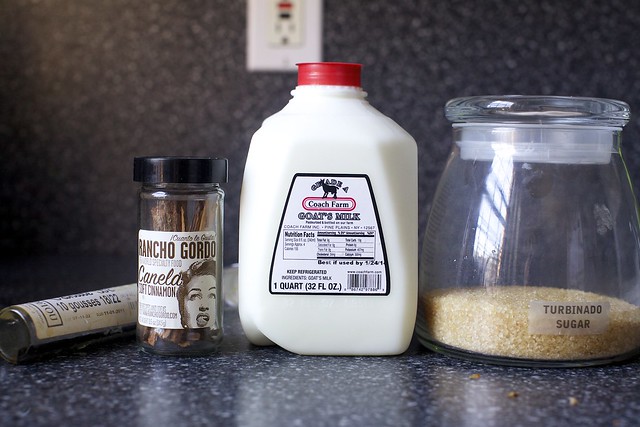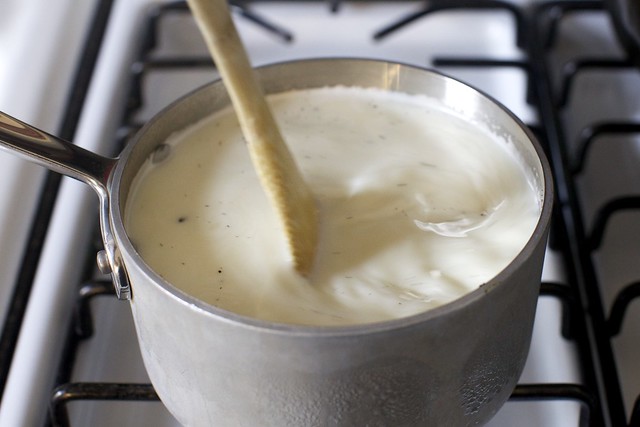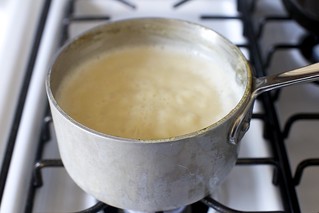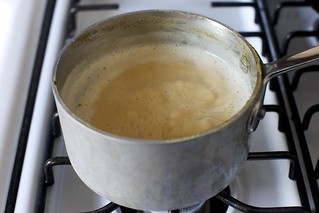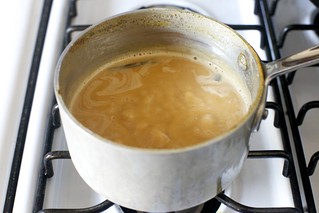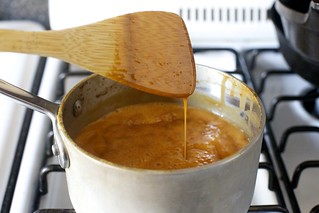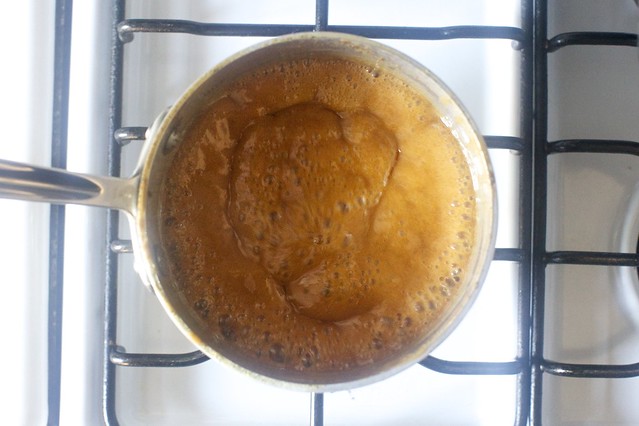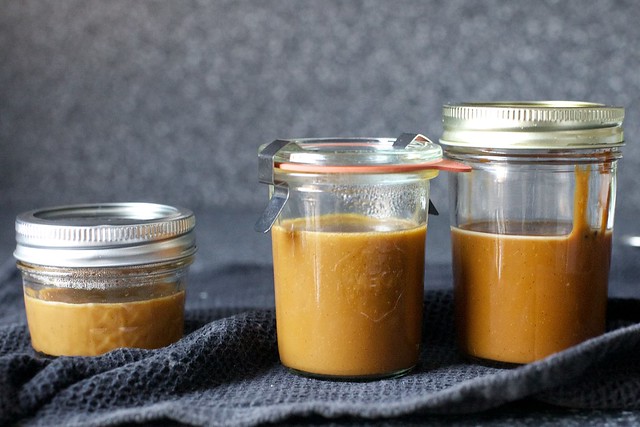Guess what, guys?! This weekend, we’re going to make dulce de leche. Or maybe cajeta. Or maybe both.
Step away from the cupboard; I don’t mean like that, the way we’ve always made it. It’s time to break up with the can of sweetened condensed milk; it’s us, not it. Because I’ve tasted the other side, the one where you take that milk in your fridge that you needed to use up anyway, the sugar that’s already in your pantry, a bit of salt, the smallest snippet of vanilla bean and maybe a cinnamon stick, if you so desire, and boil them together until it smells like the heavens exhaled in your kitchen and the mixture becomes the most complexly flavored thick copper caramel with a deliciousness will bring tears to your eyes. And no, I am not being melodramatic; you’ll see.
It’s the perfect weekend project because you’ll want to set a couple hours aside, but only about 20 minutes of it will require actual work. Plus, the Polar Vortex came back to mock those of us who didn’t take the first one seriously enough to invest in all of the silk, thermal and Gore-Tex left in the city, or so it seems this week, and really, it wants you to stay inside and cook. And it’s now late enough in January — a month that included two soups, one salad, a dairy-free dessert and a whole-wheat muffin, seriously, Resolutions, I did my time — that you’re probably ready to reintroduce decadence (or, at least refined sugar and carbs) in measured quantities. I think this is how you should do it.
Because there’s nothing quite like it. Sure, I’d follow a trail of salted butter caramel sauce to the ends of the earth, but there are times when you’re looking for something even more rich and decadent. And easier too; I know that melting sugar in a dry pan can be terrifying. This requires no such nerve-wracking processes; it is literally as easy as boiling water for the first hour or so, and then you’ll keep an eye on it and stir it regularly until it is just a slip of its original volume, intense magnification of the original taste, and oh so gooey on a crepe (filled with fresh banana and mango, here), on ice cream or on a spoon. Okay, fine, mostly a spoon.
Did you know? Dulce de leche translates, literally, a jam of milk, as in, milk jam, as in, milk candy or caramel, as I can’t believe you’re still reading this and not cooking yet. Okay, maybe not that. Its specific origins are unclear (sure, there’s the typical yarn that seems to accompany all foods — someone was making something and they forgot about it/dropped it/used the wrong flour/etc. and made something better — but I’m suspect of those) but it’s especially popular in South America, notably Argentina, Bolivia, Brazil, Chile, Paraguay, Peru, Uruguay and Venezuela, all places that I now need to eat my way through with a spoon. There are variants; according to Wikipedia the dulce de leche of El Salvador has a soft, crumbly texture, and is almost crystallized; in Colombia and Venezuela, it’s called “Arequipe” and may contain cornstarch for a custard-like texture; in the Dominican Republic, the texture is more fudge-like (less milk is used); in Puerto Rico, a coconut milk version is apparently popular, but I have found much else about this yet; and in Mexico, cajeta is most popular, which is dulce de leche made with goat’s milk. Its scope is not limited to South America, however; Indian barfi and peda are both made with condensed milk and is usually cooked until a solid candy is formed; there are flavored versions with gram flour, pistachios, cashews, rose water and/or fruit.
But you used goat’s milk: I know, thus, technically, I made cajeta. Seven years ago, I attended a demo at a local Mexican restaurant wherein, among other dishes, the pastry chef showed us how he boils a cauldron of goat’s milk with sugar each week for many hours until it becomes caramel. I was deeply suspicious; I love goat cheese of all kinds, but wouldn’t the caramel taste… goaty? Oh, silly Deb. The confection they poured over a fruit-filled crepe for our sampling was one of the top ten sweets I’ve ever encountered. There was nothing goaty about it, just a complexity of flavor (consider how much better buttermilk tastes than milk in baked goods) that made regular old dulce suddenly seem dull. I’d thought that goat’s milk would be hard to get outside a farmer’s market, but have found in the past two weeks all over the city, at Whole Foods, my local natural market and even Fresh Direct. The goats milk I bought from Coach Farms was absolutely mellow and creamy; I’m not sure it tasted any different from cow’s milk.
Basically unrelated: Seriously, how awesome are goats?
Vegan dulce: I have seen versions online of coconut milk dulce de leche and I was hoping to try it, but didn’t get to it. They look and sound delicious, but be sure to read the comments; there seems to be some concern about the fats eventually separating out. I wonder if a less fatty coconut milk would work better.
One year ago: Pasta and White Beans with Garlic and Rosemary Oil
Two years ago: Cheddar, Beer and Mustard Pull-Apart Bread
Three years ago: Roast Chicken with Dijon Sauce
Four years ago: Tomato Sauce with Onion and Butter
Five years ago: Sugar Puffs and Smashed Chickpea Salad
Six years ago: Anything-But-Clementine Clafoutis and Leek and Swiss Chard Tart
Seven years ago: Sweet and Spicy Candied Pecans
Homemade Dulce de Leche or Cajeta
Adapted loosely from Rick Bayless
Makes a little over 1 cup
If you’ve never had dulce de leche before, you’re in for a treat — a sticky, gooey, sweet treat. One of the best parts about making it from scratch is that you can control the sweetness a bit; 1 cup is the standard sugar recommendation per quart of milk, but I’ve also seen and am curious to try it with 3/4 cup. Baking soda is not mandatory here, but it’s supposed to help the final caramel not have any lumps, as well as enhancing the brown color. (Thanks, Maillard!) Some versions contain vanilla, others contain cinnamon (you can leave it in for all or part of the time, if you’re worried it’s getting too cinnamon-y), some contain both — really only add them if that’s the flavor you’re hoping for. If you don’t have a fresh vanilla bean, stir in 1 teaspoon of vanilla extract right before straining and cooling it.
1 to 2-inch segment of vanilla bean (optional)
1 quart whole milk (cow or goat, or a combination thereof)
1 cup granulated or raw sugar
2-inch segment of cinnamon stick (optional)
1/4 teaspoon coarse or flaky sea salt (optional, but ooh, it’s good here)
1/4 teaspoon baking soda dissolved in 2 teaspoons water
Split vanilla bean lengthwise. Scrape out seeds and place them, along with the empty vanilla pods, milk, sugar, cinnamon and salt (if using) in a medium-sized (err slightly on the large side) pot. Bring mixture to a simmer, stirring occasionally. Remove the pot from the heat and slowly stir in the baking soda-water mixture — it’s going to foam up if using goats milk, due to the acidity. This is why we use a larger pot; you might want to do this in the sink.
Return the mixture to the stove and keep it at a brisk simmer; if too hot, the mixture will boil over, if too low, it will take forever. Cook, checking in on it occasionally (every 15 minutes) to give it a stir to make sure nothing is sticking to the bottom, until the mixture turns a light brown, about 1 hour.
Check in on and stir the mixture more frequently (about every 5 minutes) as it begins to take on a caramel-brown color and thickens to the consistency of maple syrup, then plant yourself in front of the stove and stir the mixture until it reaches a deeper copper color.
Pour the mixture through a fine-mesh strainer [updated to note: it’s rather thick and this step can be more trouble than it’s worth; feel free to skip it and just fish the cinnamon and/or bean pods out] and into jars. Use immediately, or cool completely, storing in the fridge for up to one month with an airtight lid. Rewarm as needed to soften the caramel; a microwave is efficient but you can also warm the jar in a 1- to 2-inch puddle (shorter than the jar lid, of course) of simmering water in a saucepan until it re-liquefies. If mixture seems too thick to pour even after fully reheating, you can stir in a little water, 1 teaspoon at a time.
Serve it: Over everything. Here, I drizzled it on some leftover part-whole wheat crepes from a blintz project (cheese blintz recipe, anyone?) filled with sliced bananas and mango, but it’s also wonderful on ice cream, cakes, churros, or a spoon.
Share this:
Related
ncG1vNJzZmirnZ7BtbHNpKCtm5iau2%2BvzqZma2hhaXxxfY6hpqadnZaxpnnDrqOcnV2Zsm64xJyfnmc%3D
